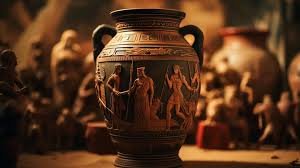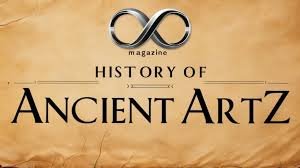Ancient Artz provides a captivating glimpse into bygone eras, revealing the traditions, beliefs, and daily routines of ancient civilizations. Throughout history, artwork, ranging from the vivid cave paintings of early humans to the iconic statues of ancient Greece, has beautifully encapsulated the values and dreams of its makers. This article guides you through the enchanting realm of Ancient Artz, encompassing millennia of history, a rich tapestry of cultures, styles, and methods. By grasping the essence of these enduring works, we develop a heightened recognition of their enduring influence on contemporary society.
Exploring the Beginnings of Ancient Art: Early Forms of Human Expression
The tale of Ancient Artz commences with ancient humans, who utilized art not merely for its beauty but also as a means of conveying profound cultural and spiritual convictions. Cave paintings such as the ones discovered in Lascaux, France, represent some of the oldest instances of Ancient Art, depicting depictions of animals and hunting with probable ritual importance. These ancient artistic expressions were thought to enhance hunting success and foster a deep connection with the world of nature.

Prehistoric art featured sculptures such as the Venus figurines, embodying themes of fertility and femininity. These artifacts offer a window into the spiritual and social ideologies of ancient civilizations, granting us a peek into their distinct perspectives and customs.
| Topic | Description |
|---|---|
| Origins of Ancient Art | Traced back to prehistoric times, featuring cave paintings and figurines that represent early human beliefs and rituals. |
| Egyptian Art | Centered around religion and power, showcasing impressive pyramids and intricate hieroglyphics to pay tribute to gods and rulers. |
| Greek Classical Art | Focuses on proportion, realism, and beauty, establishing the groundwork for the Western artistic heritage. |
| Roman Propaganda Arts | Utilized as a means of reinforcing authority, depicting realistic portraits and monuments to highlight power and accomplishments. |
| Chinese Art | Influenced by nature and philosophy, highlighting harmony and equilibrium through calligraphy and sculpture. |
| Enduring Impact | Left a significant mark on Renaissance and modern art, architecture, and design. |
Exploring the Intersection of Religion and Power through Ancient Egyptian Art
The ancient Egyptian art is celebrated for its unique style and deep symbolic meaning, with many pieces reflecting religious and political influences. This particular manifestation of Ancient Art gracefully upheld two significant roles: paying homage to the divine and guaranteeing a secure journey for the departed soul towards the realm beyond. Egyptian art has incredibly preserved a uniform style throughout the centuries, as can be seen in hieroglyphics, tomb paintings, and sculptures.
The magnificent Egyptian monuments, like the pyramids and the Sphinx, showcase the Egyptians’ deep respect for the divine essence of their pharaohs. Every component in Egyptian art, such as the postures of the figures and the utilization of color, held deliberate symbolism and contributed to the portrayal of religious stories.
Explore the Classical Foundations of Western Art through Ancient Greek Art
Ancient Greek art marks a significant transition in the realm of ancient art, establishing the groundwork for a substantial portion of the Western artistic heritage. Greek art is renowned for its emphasis on proportion, realism, and the portrayal of the perfect human physique. It exalts beauty, intellectual prowess, and a sense of community pride. Iconic sculptures such as the Discobolus (the Discus Thrower) and Doryphoros (the Spear Bearer) exemplify the Greek fascination with perfect beauty and harmony.
Greek art went beyond being used for religious or political reasons and instead celebrated athleticism, philosophy, and community life. The Parthenon stands as a symbol of Greek architectural and artistic excellence, honoring Athena as its dedicated deity. The intricate friezes and sculptures adorning the Parthenon intricately weave stories that showcase the Greeks’ adeptness at form and dedication to narrating tales through art.
Roman Art: Utilized as a Means of Propaganda and Influence
Drawing inspiration from Greek art, Roman art emphasized realism and practicality, while maintaining its own unique purpose. Roman art had a crucial role in propaganda by strengthening authority and portraying prominent individuals. Portraits depicting emperors and military leaders conveyed authority and dominance, whereas public monuments such as triumphal arches commemorated military triumphs.
Roman art extended beyond the boundaries of the privileged class. Common objects such as pottery and mosaics were skillfully designed, allowing Ancient Artz to be enjoyed by individuals across all levels of Roman society. The utilization of art in Roman culture for both practical and aesthetic purposes beautifully mirrors the values and daily routines of the civilization.
Chinese Art: Embracing Harmony with Nature and Philosophy
Art in ancient China was intricately intertwined with nature, spirituality, and philosophical wisdom. Chinese Ancient Artz highlighted the importance of harmony and balance, drawing inspiration from Confucianism, Taoism, and Buddhism. Calligraphy, landscape painting, and sculpture have emerged as key forms of artistic expression in China, often portraying the interconnection between humanity and the natural environment.
An iconic Ancient Chinese artwork is the Terracotta Army, comprising life-sized sculptures crafted to protect Emperor Qin Shi Huang in the world beyond. Chinese landscape painting, which gained popularity during the Tang and Song dynasties, prioritized conveying the spirit of nature over exact representation, reflecting principles of tranquility and harmony that remain relevant in modern times.
The Enduring Impact of Ancient Artz
The impact of Ancient Artz has heavily influenced several contemporary artistic movements. During the Renaissance, classical Greek and Roman ideals were revived. Artists such as Michelangelo were inspired by ancient sculptures and architecture. Nowadays, Ancient Artz serves as a perpetual source of inspiration for modern art, architecture, and design, highlighting its enduring significance. Museums around the globe carefully preserve these artifacts, demonstrating how art possesses a universal charm in conveying intricate notions regarding spirituality, governance, and humanity.
Frequently Asked Questions
May I inquire about the nature of Ancient Artz?
Ancient Artz encompasses the artistic creations of past civilizations, such as paintings, sculptures, and architectural marvels, typically crafted for purposes of religion, society, or politics.
What makes Ancient Artz so important?
Ancient Artz offers valuable insights into the beliefs, customs, and everyday lives of ancient societies, aiding in our comprehension of their cultural and spiritual traditions.
What impact did Greek art have on shaping contemporary culture?
Ancient Greek art highlighted realism, proportion, and ideal beauty, establishing the foundations of Western art customs, fueling the creativity of Renaissance artists, and leaving a mark on contemporary architecture and sculpture.
What sets Roman art apart from Greek art?
Roman art heavily drew from Greek techniques, highlighting realism and propaganda to showcase power and authority through portraits and monuments.
What set Chinese art apart from other ancient artistic traditions?
Chinese Ancient Artz cherished the idea of being in tune with nature, drawing inspiration from Taoism and Confucianism. They frequently showcased landscape paintings that beautifully encapsulated the serenity of the natural surroundings.
